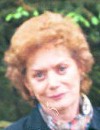An American Czech-born woman who produced watercolours ordered by Nazi doctor Josef Mengele in the death camp of Auschwitz has been leading a long battle to recover her works from the Auschwitz Memorial Museum in Poland.  Dinah Gottliebova-Babbitt, now 76, was arrested in 1944 with her mother by the Nazis in Brno, Czechoslovakia, and sent to Auschwitz-Birkenau where her goalers discovered her talents as an artist. She had studied art in Brno and Josef Mengele, the mad doctor of Auschwitz who conducted some atrocious medical experiments on many detainees who used to call him "the death angel", ordered her to paint the portraits of Gypsies before they were sent to the torture room or the gas chamber.
Dinah Gottliebova-Babbitt, now 76, was arrested in 1944 with her mother by the Nazis in Brno, Czechoslovakia, and sent to Auschwitz-Birkenau where her goalers discovered her talents as an artist. She had studied art in Brno and Josef Mengele, the mad doctor of Auschwitz who conducted some atrocious medical experiments on many detainees who used to call him "the death angel", ordered her to paint the portraits of Gypsies before they were sent to the torture room or the gas chamber.
Mengele pretended he needed such portraits for his documentation regarding his scientific studies on Mischling (mixed races) people after finding that mere photos had less renderings than watercolours as for the colour of hair and skin of detainees who served him as guinea-pigs.
Dinah, who bore the detention number 61 016 on her arm- all detainees being marked in such way on arrival- produced some striking realistic portraits of Gypsy detainees and worked as slowly as possible so as to delay their fate. None of the Gypsies portrayed survived and Dinah escaped death thanks to her brush.
At the end of the war Dinah immigrated to the U.S and worked in a cartoon studio.
Meanwhile, the watercolours had been recovered by a detainee who kept one for himself while six others were given by a fellow prisoner to a young Hungarian Jewess inmate who was adopted by an inhabitant of Auschwitz three days after the camp was freed by Soviet troops.
In 1963, the young woman, who had become a dentist in Krakow, offered the watercolours she had kept to the Auschwitz Museum which later acquired the remaining work. Two years later, a Museum employee discovered in the book "Tovarna na smrt" (The factory of death) that a painting was signed with the same initials found on the watercolours. Dinah learned in 1973 that her works had survived and flew immediately to Poland, her daughter Karin said.
She came back in a delusive mood after the Museum had refused to give her back her watercolours but had not the means to hire a legal counsel to sue the Museum.
The Auschwitz Museum has given a different version of the case saying that Dinah Gottliebova had told them of the circonstumces in which she had been led to paint these works and added that being happy to have survived she only wanted their photographic reproductions.
 Dinah tried again to recover her works, this time with the assistance of a lawyer but met another refusal from the Museum which only accepted to lend these for a temporary exhibition in the U.S.
Dinah tried again to recover her works, this time with the assistance of a lawyer but met another refusal from the Museum which only accepted to lend these for a temporary exhibition in the U.S.
In the view of the Museum the watercolours have simply a documentary value and are kept to preserve the memory of Auschwitz.
"The Museum has been created to honour the memory of those who perished in Auschwitz-Birkenau. We understand the emotional reaction of Mrs Gottliebova but what would happen if other survivors or their heirs came forward to claim back what belonged to them", a spokesman for the Museum stressed.
Mrs Gottliebova-Babbitt has called upon U.S congressmen to help her while an Internet site (www.survivorart.com) has become the centre point of heated debates betwen Poles and Jews who have sided in favour of the plaintiff claiming that the Museum has been cashing on copyright payments for the works which Dinah wants to give to the Gypsy community. Poles have been defending themselves by saying that their country has been financing the existence of the Museum to pay homage to the victims of Nazi atrocities and asked whether the impressive packs of hair, shoes and glasses amassed in the sombre cloakrooms of Auschwitz should also be auctioned.
At the time being, only copies of the watercolours are shown to the visitors of the Museum, the original works being on the walls of former Block 25 now reserved for the administration of the Auschwitz institution.
PLEASE HELP
Write, call or email the following people, expressing your desire to see Dinah
re-united with her artwork: Cultural Attache
Embassy of Poland
2640 16th Street NW
Washington, DC 20009
Minister Andrzej Zakrzewski
The Ministry of Culture and Art
Ministerstwo Kultury i Sztuki
Krakowskie Przedmiescie
15 / 17, Warsaw
Telephone: +48 620-0231
Fax: +48 826-7533
Bronislaw Geremek
Polish Ministry of Foreign Affairs
mszdpi@atos.warman.com.pl
Ambassador Stewart E. Eizenstat
US Department of State
Undersecretary of State for Economic Business
Agricultural Affairs
Washington, DC. 20520-7512